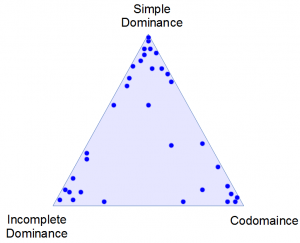Dominance
In genetics, dominance describes a relationship between different alleles and their effect on a phenotype. There are different forms of dominance.[1] Many organisms we interact with, including humans, are diploid which means that they contain two copies of most genes instead of one. This added complication probably delayed a precise understanding of the rules of genetic inheritance until the 19th century.
Contents
Forms of Dominance
- Simple Dominance
- Incomplete Dominance (and semi-dominance)
- Codominance
- Other Types of Dominance
It is easier to begin with distinct categories of dominance but ultimately the effects of dominance can be though of as a continuum with specific phenotypes falling at different points within this space. Most phenotypes are more like one category or the other, but many have a mix of types of dominance.
Simple Dominance
In Simple Dominance the heterozygotes display the same phenotype as one of the homozygotes, and this is the dominant phenotype. The phenotype that does not appear in the heterozygotes is the recessive phenotype. (For brevity these are usually referred to as the dominant and recessive alleles, but this is inaccurate. See the footnote below.)
Example: Say we have a "wildtype" allele of a gene that results in normal levels of melanin (skin and hair pigmentation among other things) deposition. And a non-functional (amorph) allele that does not deposit melanin in the skin or hair. A wildtype homozygote (two copies of the same allele) would have normal pigmentation. An amorph homozygote would lack pigmentation and be identified as an albino individual. What would happen in a heterozygote (a copy of two different alleles) that had one wildtype and one amorph alelle? For a wide range of gene having one copy of a functional allele is sufficient (haplosufficient) to produce a wildtype phenotype. So in the heterozygote the wiltype allele results in normal levels of pigment deposition. The non-functional amorph allele has no effect and the individual is not albino. Therefore, the phenotype that appears in the heterozygote is dominant (normal pigmentation) and the phenotype that is absent is recessive (albinism). Since the heterozygote is phenotypically equaivalent to one of the homozygotes this is a case of simple dominance.
Incomplete Dominance
Codominance
Other Types of Dominance
(Over- and under-dominance)
Common Misconceptions
- ↑ Also, it is hard to see this at first, but it becomes important later on, dominance is a quality of the phenotype, not the genotype or alleles. The same genotype can have a range of phenotypes that have a range of dominance characteristics.
